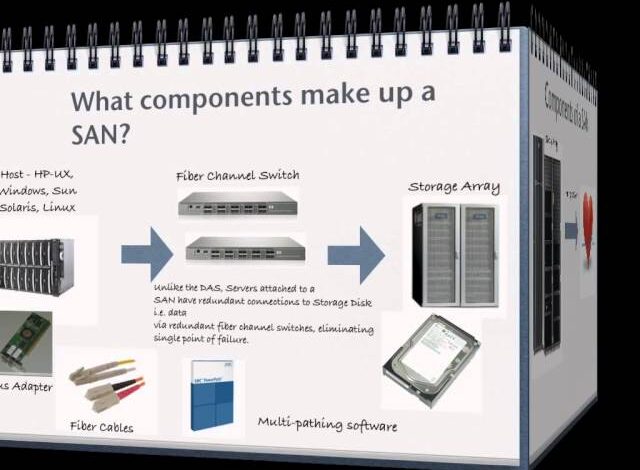The Complete Breakdown of SAN Storage Pricing Components

SAN networks accelerate data access and support application workload performance and availability requirements. A key element in a SAN is the fabric layer, which includes fiber channel switches and cables that establish any-to-any connections between servers and storage devices.
SANs also provide high storage availability, as a single cable or device failure can often be overcome by using multiple routes to access the same storage devices. SANs also offer benefits like networked logical volume management and filesystem-level error correction.
Cost per Gigabyte
If you’re shopping for storage devices like hard drives or SSDs, knowing the price per gigabyte (GB) is essential to get the best deal. This straightforward calculation can compare prices across vendors, models, and capacities. You can also use this method to determine the total installation cost, including setup fees, hardware costs, software licensing, and ongoing support.
To calculate the price of a storage device in GB, you must first convert the advertised capacity from terabytes (TB) to gigabytes (1 TB = 1000 GB). You may also need to multiply by 100 to ensure that you’re comparing apples to apples. Vendors often advertise storage capacities in TB, so it’s essential to understand that you must always convert to GB before performing the calculations.
A SAN allows you to store data offsite and access it from anywhere. This can improve performance and reduce risk by removing the need for enterprise workloads to compete with other network traffic for LAN bandwidth. Moreover, a SAN can improve storage availability by allowing administrators to treat storage as a collective resource. A single cable or device failure won’t render storage inaccessible to enterprise workloads.
In addition, a SAN can improve storage utilization by eliminating “forgotten” disks on underutilized servers. However, it’s important to note that SAN storage is typically more expensive than NAS solutions.
The SAN storage pricing depends on several factors: capacity and connectivity. A SAN can be connected via Fibre Channel (FC), iSCSI, or FCoE, but FC provides the fastest transfer speeds and is typically used in enterprise environments. In contrast, iSCSI and FCoE are slower and more cost-effective for small to mid-sized deployments.
Another consideration is that a SAN requires specialized hardware to function correctly. This includes HBAs, fiber cables, switches, and Fibre Channel-connected storage devices. A SAN can cost as much as $100,000 for a small deployment, but larger systems can cost well over $1 million. The lower operating costs associated with a SAN can offset this high initial cost. Additionally, a SAN can save money by reducing IT staff time and managing storage hardware. “By doing this, we can allocate resources to other projects and endeavors, increasing efficiency and productivity.” This can result in greater productivity, profitability, and business growth. Finally, a SAN can help companies meet regulatory compliance and disaster recovery requirements by improving IT’s ability to manage business-critical applications.
Cost per Gigabit
SANs are a relatively expensive alternative to direct-attached storage (DAS). But they are also more complex and require specialized knowledge and skills to deploy, manage, and troubleshoot. As a result, IT leaders must weigh the pros and cons of SANs against other options for storing, deploying, and managing critical data.
Unlike network-attached storage (NAS), which provides an intermediary layer between client computers and storage, storage area networks (SANs) connect directly to storage devices like hard disk drives, optical media, or tape drives. SANs provide maximum performance, as data is transferred directly between the client and storage devices without any encapsulation or translation by a server.
The SAN market has grown significantly due to increasing demand for high-performance, reliable, and manageable storage solutions. The market is also experiencing increased adoption of all-flash storage, which offers better performance and lower total cost of ownership than traditional HDDs.
In the current market, SAN vendors offer an array of all-flash and hybrid flash/HDD storage systems. Leading players in this space include Fujitsu, Lenovo, Dell, HPE, and Western Digital. Other popular SAN vendors include Kaminario, Pure Storage, IntelliFlash, and Violin Systems.
A Storage Area Network (SAN) is a system that eliminates single points of failure to enhance storage reliability and availability. This is accomplished by distributing the load across multiple servers and implementing storage clusters that can fail over to each other in case of a hardware malfunction or software error. In addition, a SAN can provide data replication and centralized storage management.
Besides the storage fabrics, a SAN includes an assortment of internal technologies to increase storage utilization and performance. These technologies include RAID, storing data on multiple disks to increase capacity and resilience, storage cloning, thin provisioning, and deduplication. A SAN can be further enhanced with advanced features such as snapshots, cloud backup, and auto-tiering.
Although a SAN can be deployed on a small scale, it’s generally effective only in larger environments with many servers and significant storage. This is because the SAN infrastructure consists of a second network requiring costly HBAs on each host server, switches, cabling within a redundant fabric, and specialized storage processor ports at the storage arrays. This can prove expensive for smaller IT organizations that need more resources to design and monitor such a complex environment. Fortunately, SANs can be simplified with Fibre Channel over Ethernet (FCoE), which enables the transmission of FC packets over IP networks. This can reduce storage network complexity and improve flexibility. Moreover, implementing FCoE can make it easier for IT teams to integrate SANs into existing enterprise networks.



